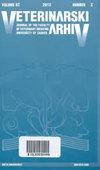饲粮中添加辣木粉对杂交犊牛抗氧化能力的影响
IF 0.3
4区 农林科学
Q4 VETERINARY SCIENCES
引用次数: 0
摘要
本试验旨在评价在混合日粮中添加辣木粉替代混合精料对杂交犊牛的抗氧化作用。选择21头杂交小母牛,按体重和年龄分为3组。将辣木叶(84%)和软枝(16%)混合制成辣木粉。分别以50%、23%、25%、1%和1%的混合浓度配制混合料、坚果碎秸、杂交草、矿物混合物和普通盐配制对照混合总日粮(T1)。以5.0%和7.5%的辣木粕代替复合精料配制总混合口粮T2和T3。试验开始(第0天)、中期(第60天)和结束(第126天),在饲喂和浇水前的早晨采集每头犊牛的全血。杂交小母牛犊牛的总白细胞计数、总红细胞计数、红细胞压积和血小板计数在各处理组间差异不显著(P>0.05),均在正常生理范围内。血清白蛋白、葡萄糖、肌酐、尿素、碱性磷酸酶、丙氨酸氨基转氨酶、钙、磷在两组间差异无统计学意义。饲粮中添加辣木粉比添加5.0和7.5%辣木粉效果更好(P0.05)。在混合日粮中添加5.0和7.5%辣木粉替代高蛋白复合精料,对生长中的杂交母牛血液生化指标无不良影响,抗氧化能力不显著(P>0.05)提高。本文章由计算机程序翻译,如有差异,请以英文原文为准。
Assessment of Moringa oleifera meal supplementation on the antioxidant status of crossbred heifer calves
The experiment was conducted to evaluate the anti-oxidant effect of Moringa oleifera meal-supplementation in the total mixed ration, replacing the compounded concentrate mixture for crossbred heifer calves. A total of twenty-one crossbred heifer calves were selected and grouped into three treatments based on body weight and age. The leaves (84%) and soft twigs (16%) of Moringa oleifera were mixed to prepare the Moringa oleifera meal. Compounded concentrate mixture, ground nut straw, hybrid napier grass, mineral mixture and common salt were used at 50, 23, 25, 1 and 1%, respectively to formulate the control total mixed ration (T1). The compounded concentrate mixture was replaced with the Moringa oleifera meal at 5.0 and 7.5 % to formulate total mixed rations T2 and T3. The whole blood was collected from each calves in the morning before feeding and watering at the beginning (0 day), middle (at 60 day) and end (at 126 day) of the experiment. The total leukocyte counts, total erythrocyte counts, haematocrit and platelet count of crossbred heifer calves differed non-significantly (P>0.05) between the treatment groups, and were within normal physiological range. The serum albumin, glucose, creatinine, urea, alkaline phosphatase, alanine amino transaminase, calcium and phosphorus differed non-significantly between the treatment groups. However, feeding with Moringa oleifera resulted in higher (P0.05) higher after feeding with the 5.0 and 7.5% Moringa oleifera meals. Feeding with 5.0 and 7.5% Moringa oleifera meal in the total mixed ration, replacing the high protein compounded concentrate mixture, to growing crossbred heifer calves had no adverse effect on haematological and biochemical constituents, and resulted in a non-significant (P>0.05) higher antioxidant capacity in the crossbred heifer calves.
求助全文
通过发布文献求助,成功后即可免费获取论文全文。
去求助
来源期刊

Veterinarski Arhiv
VETERINARY SCIENCES-
CiteScore
0.80
自引率
20.00%
发文量
22
审稿时长
6-12 weeks
期刊介绍:
The journal Veterinarski arhiv (Vet. arhiv) publishes original scientific papers, case reports, short communications, review papers and book reviews. Occasionally, in supplemental issues, it publishes papers of relevant conferences. The scope of the journal includes all fields of veterinary and animal sciences. Veterinarski arhiv is published by the Faculty of Veterinary Medicine University of Zagreb, six times a year, as an open access, peer-reviewed, international scientific journal. Only unpublished manuscripts may be accepted for the review process. All papers must be written in English and submitted via the Journal''s online submission system (COMET). The content of the Journal is available free of charge and there are no publication charges.
 求助内容:
求助内容: 应助结果提醒方式:
应助结果提醒方式:


